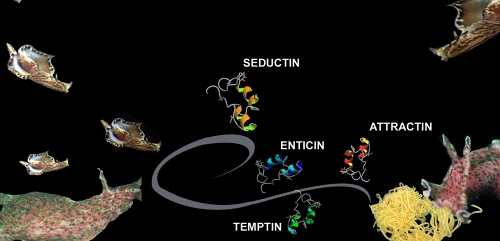The Aplysia language of love
February 16, 2007
From: Scott Cummins

Hi Bill,
I'm interested in sea slug communication and am particularly interested in the mating aggregations that are posted in the Forum. I've been part of the research group in Galveston, Texas, studying chemical communication between Aplysia species. We've found that Aplysia use chemicals (pheromones) to talk with each other. Aplysia has been a particularly good study choice for us because of its well studied reproductive cycle and we knew that egg masses themselves could attract other Aplysia to create the breeding aggregations. Essentially they are trying to tell other Aplysia in the area that they need more sperm, and because they are hermaphrodites they can donate sperm too. As molecular biologists, we can easily manipulate them into laying eggs and collect any pheromones that may also be released. Just to extend on your review of the single pheromone discoveries [message #17419 ]:
We now know that at least two Aplysia species, Aplysia californica and Aplysia brasiliana, release multiple pheromones (they are all small novel proteins) to attract potential mates and stimulate other reproductive behaviours (see refs). So, when an animal lays an egg mass they are also releasing at least 4 pheromone messages into the surrounding seawater, which we've called attractin, enticin, temptin and seductin (see cartoon figure; unpublished) after extensive behavioural analysis. To our knowledge, this is the first invertebrate water-borne cocktail pheromone system to be identified. The reason they need more than one pheromone .....well, we're not sure yet, but probably it gives the detecting animal more information (like we use more than one word to give greater detail), and may provide some kind of species specificity.
So the Aplysia aggregations and mating chains that we see may be caused by this special language that probably only other Aplysia species can sense. The pheromones that are released into the surrounding seawater don't appear to be very species specific, which results in attraction of different species (even A. brasiliana swim to A. californica pheromones). As you've said, there's probably a chemical they recognize upon contact which tells them to get off if they are different species but we haven't discovered this yet. It will be interesting to see if other sea slugs communicate in a similar way.
I plan to further decode this molluscan communication language at University of Queensland in Brisbane, Australia. I'd be interested to hear from anyone who has seen any local Aplysia aggregations in the area and further evidence of multi-species aggregations.
-
Cummins SF, Nichols AE, Amare A, Hummon AB, Sweedler JV, and Nagle GT. (2004) Characterization of Aplysia enticin and temptin, two novel water-borne protein pheromones that act in concert with attractin to stimulate mate attraction. J. Biol. Chem. 279: 25614-25622.
-
Cummins SF, Nichols AE, Warso CJ, Nagle GT. (2005) Aplysia seductin is a water-borne protein pheromone that acts in concert with attractin to stimulate mate attraction. Peptides 26: 351-359.
-
Cummins SF, Nichols AE, Schein CH, Nagle GT. (2006) Newly identified water-borne protein pheromones interact with attractin to stimulate mate attraction in Aplysia. Peptides 27(3): 597-606.
-
Cummins SF, Xie F, Misra M, Amare A, Jakubowski J, de Vries MR, Sweedler JV, Nagle GT, Schein CH. (2007) Recombinant production and structural studies of the Aplysia water-borne protein pheromone enticin indicates it has a novel disulfide stabilized fold. Peptides [Jan 2007].
Thanks.
Scott Cummins.
s.cummins@uq.edu.au
Cummins, S.F., 2007 (Feb 16) The Aplysia language of love. [Message in] Sea Slug Forum. Australian Museum, Sydney. Available from http://www.seaslugforum.net/find/19464Dear Scott,
Firstly welcome to Australia. I have been following your work with interest for some years. I guess we are often only aware of large breeding aggregations when misfortune occurs and they become mass mortality events.
I am sure you will have no problem finding Aplysia populations around Brisbane. What may be interesting is seeing if Bursatella leachii has similar pheromones. One of the first messages to the Forum, nearly 10 years ago, was from the manager of a prawn aquaculture business just south of Brisbane [message #359] who had great numbers of Bursatella in his ponds.
Good luck with your work, please keep us informed of your progress,
Best wishes,
Bill Rudman
Related messages
-
Re: Sea Hare 'Love Drug'
From: Bill Rudman, August 14, 2006 -
Sea Hare 'Love Drug'
From: Bill Rudman, March 8, 2003 -
Aplysia dactylomela mating chains
From: Anne DuPont, May 27, 2002 -
Asexual reproduction?
From: Wilson, February 2, 2001 -
Aplysia mating chain
From: Bill Rudman, May 9, 2000 -
Sea Hares - mating chains
From: Erwin Koehler, June 4, 1998
